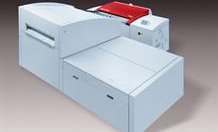
What markets is it aimed at?
The Energy Elite Pro is aimed at the more demanding, longer-run markets such as consumer magazine and catalogue printers. Here, the thermal plate’s durability beyond the standard 100,000 run length is a key selling point as it can cope with longer runs if the printer takes on a big catalogue or magazine job.
“For printers who might have a job once in a while of 250,000 magazines or catalogues, they’ll need a plate that can handle this so they don’t have to keep swapping back and forth,” say Koni Neuhofer, business manager pre-press at Agfa Oceania. The plate is also likely to appeal to packaging printers: although they typically have shorter runs, they’re more likely to use aggressive UV inks.
What’s new?
According to Agfa, the Energy Elite Pro plate is an all-round improvement on their Energy Elite plate that has been on the market for several years. Neuhofer says: “As a leading plate manufacturer, we continually strive to improve and bring better products to the market.”
With the Energy Elite Pro, the stability is improved on long runs, as is its unbaked run length on UV and non-UV jobs.
“It lasts longer on the press and it’s slightly improved ecologically as it uses less chemistry at the processing stage. Because it has an increased bath life of up to 7,000m2 and lower replenishment rates of 50ml/m2, chemical waste is also reduced,” says Neuhofer.
Agfa says the higher sensitivity means the plate can also be imaged faster, but this depends on the platesetter. “Let’s say your platesetter did 30 plates per hour before, it might do 31 with the Energy Elite Pro, but that’s only if the platesetter is capable of going at the higher speed.”
“The improvement is to do with the changing of the components. We actually refer to it as a recipe – it’s like a cake. Better ingredients come along and you change other ingredients and ratios.”
How does it work?
The Elite Pro is a dual-layer plate, which Neuhofer says gives it a higher resistance to UV inks than simpler single-layer plates. Whereas simpler plates are covered in minute latex spores – with the image created by a laser melting those spores and a simple cleaner clearing away the non-imaged areas – the dual-layer plates have to go through a chemical processor with developer, finisher and gum. This makes the plate more robust and suitable for more “aggressive” printing environments.
How about training and support?
Agfa employs application specialists whose job it is to first ensure the platesetter is properly calibrated and linearised and that the density in the processor is right, then to work with operators to ensure all the settings are correct. The amount of training and support needed to help printers switch from their old plate depends on the printer. “Some printers are very proficient so you could almost post the plate to them and they’d be okay. But for others, it’s even more crucial that we have experts who can help them get the best out of the product. The specialists also make sure that the chemistry levels on the processor are turned down from the old plate, so the new plate delivers on being more environmentally friendly.”
What CTP is it compatible with?
The Energy Elite Pro is designed for use with a wide variety of thermal platesetters and processors, including Agfa Graphics’ recently introduced high-speed Avalon N8-80XT.
Specifications
Run length: 300,000-400,000 unbaked
Resolution: 1%-99% at 200lpi and 20 micron FM
Bath life: Up to 6,968sqm
Replenishment rate: 50ml/sqm
Price: Dependent on volume ordered
Contact: Agfa 1300 363 396 www.agfa.com
The alternatives
Fujifilm Brillia HD LH-PLE
This thermal plate works with UV inks on medium runs needing to be baked. To withstand stresses during long runs, the Brillia HD LH-PLE incorp-orates a new alloy base to resist cracking and splitting, reducing the need for costly remakes and downtime, says Fujifilm. It can be baked for higher run lengths.
Run length: 300,000 unbaked
Resolution: 1%-99% at 200lpi and 20 micron FM
Bath life: Up to 8,000m2
Replenishment: Typically 7-10ml/m2
Contact: Fujifilm (02) 9466 2600 www.fujifilm.com.au
Kodak Electra XD thermal plate
The Electra XD Plate supports high-res imaging to deliver consistent, high-quality printing. Kodak says the plate delivers sharp detail for extremely long, stable runs in both AM and FM applications. Like the Energy Pro, the Electra XD’s lower developer consumption, longer bath life and cleaner processing reduces cost per plate and minimises chemical waste.
Run length: Up to 500,000 unbaked; 1 million-plus baked
Resolution: 1%-99% at 450lpi
Bath life: Up to 12 weeks or 8,000m2
Replenishment rate: 30-60ml/m2
Contact: Kodak (03) 8417 8000 www.graphics.kodak.com/AU/en
This article includes reporting from printweek.com
Comment below to have your say on this story.
If you have a news story or tip-off, get in touch at editorial@sprinter.com.au.
Sign up to the Sprinter newsletter

